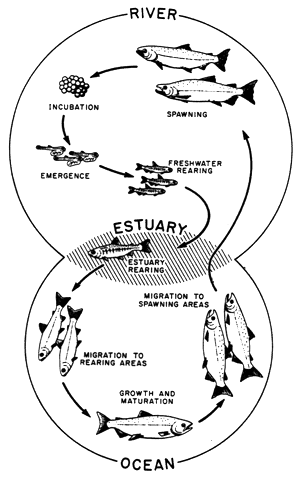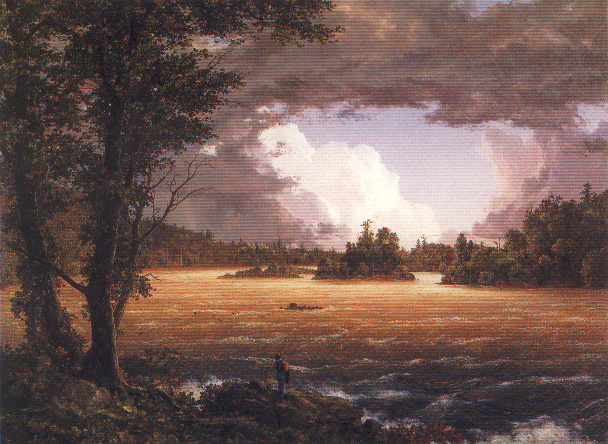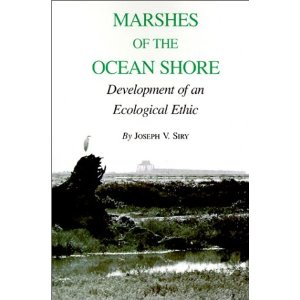|
The older triad of values along a spectrum
|
||
| Spiritual |
Useful |
|
wild |
 |
 tame tame |
|
The older triad of values along a spectrum
|
||
| Spiritual |
Useful |
|
wild |
 |
 tame tame |
Estuaries and The New Ecology: How the ecology of estuaries was examined and explained


Review | Key Players | Significant Idea | Summary | Concluding example
"The expansion of wisdom is a difficult task for an individual,
let alone a society. In
democratic cultures wisdom often may be overlooked at The voting boot in The
formulation of policy. For citizens and civil servants alike, confronting popular
notions of efficacy and justice takes courage. Rachel Louise Carson was an advocate
of unpopular causes, including fish and bird protection, preservation of wild
seashores, and opposition to heedless use of 'miracle' technologies. Her final,
best known attack on The indiscriminate uses of DDT as an insecticide was only
one part of her larger and more positive view of The world and humanity's place
in The eco - energetic scheme.... More than any other scientist she popularized
The oceans and The shores, with a profoundly religious respect for nature and
a practical appreciation for human ignorance. A contemporary of her fellow preservation
ecologist, Aldo Leopold, Carson focused more explicitly than he on oceans and
shores."
Land Ethic
PlanningWater
city or urban
Key Players
Review of Chapter Seven's main points:
Rachel Carson's tradition 1937-1668.
Popularization of the Sea before and especially after the warCity Planning and scenic preservation in 1920sMay 27, 1927, Rachel Carson was born in Springdale ,Pa.
1936 article in the Baltimore Sun on the Chesapeake Bay
Fish and Wildlife Coordination Act of 1934 to remedy single factor planning perspectives.
Federal Conservation Policy reformulation from Hoover to Ickes and river protectionThe Sea Around Us (1951)Carson's books
Carson in the US Fish and Wildlife Service
"takes away land suitable for wildlife" she argued as cities and highways were built and marshes were destroyed in the process.
Osborn, Brown and Commoner all stake out ecological problems due to population, resources and technology as causal factors.
National Book AwardEdge of the Sea (1955)
tideland habitats and their creatures
Place of our ancestral beginnings
A sense of wonder for seashore life
"essential unity that binds life to the earth"
Basis of the marine food chain: dinoflagellates, diatoms and copepods: the plankton.
Oysters and filter feeders"awareness of its beauty, and its deeper meanings, sensing the intricate fabric of life where one creature is linked to another and each with its surroundings."
page, 142.Eugene Odum's work (1954) in the Georgia Sea Islands."arteries of a remarkable energy absorbing natural system whose heart was the pumping action of the tides"
Farm in the midst of Chesapeake Bay marshes.
Claude Zobel and the role of bacteria and soil fungus in productivity of plants.
Between Pacific Tides, Ed Ricketts, John Steinbeck and the Monterey Bay fisheriesShipworms and San Francisco Bay water quality changes
Water content of the hydrological system
water quality decline threatened estuaries nationally
Ties Lindeman's study to marsh grass productivity and Odum's rationale.
"We tend to see that estuaries tend to be more fertile than either uplands on one hand or the sea on the other." Eugene Odum, 1961.
Comprehensive Planning themeSpartina grass, mud algae, diatoms and the productive base of tidal marshes
What accounts for productivity of wetlands?
The fertility of tidal seas is unsurpassed due to animals and plants found nowhere else. These bacterial life forms called "protoctista" are able to live in either oxygen abundant (Oxic) or oxygen scarce (Anoxic) situations and some thrive under both conditions. This area shown in the animation above is an important edge where one significant component of seaside production is apparent. This productive zone, deeper in the muds and sand flats, is a source of the prolific life that thrives in coastal marshes.
The ocean's temperate conditions, a coastal edge effect, and abundant nutrients are a triad of conditions contributing to the productive potential of this seaside nursery.
page, 146.
The economic returns from and thus the marginal utility of a corn field is greater than an estuary -- but an estuarine marsh is biologically greater in productivity where the yield in terms of fish caught along the shore, or offshore, or out at sea is reaped, not by the land owner, but by the fisher, the fisher's family or the canneries that process the fish. The fisheries, such as salmon, shrimp or blue crab, clams, sardines or oysters, all depend on the healthy functioning of clean and relatively undisturbed estuaries where coastal marshes help to nourish young fish, shrimps, crabs and mollusks.

Problems of the merely agronomic approach to marshes is similar to one dimensional planning.
Need for coastal restoration districts based on the Soil Conservation District concept.
regional planning strengths and weaknesses
Planning movement, cities and transportation
Philadelphia transportation plan: PenJerDel
Suburban growth --as pictured here in the San Fernando Valley, just 20 miles from the coastline-- was enabled by the diversion of fresh water from estuaries and the progressive belief that home ownership was a strengthening element in post World War One America.
As the expansion of automobile roads and railway lines spurred the rapid development f land into suburbs, several cities began to become interested and promote regional planning.
Henry Wright -- NY State Commissioner of Housing define planning's goal
so that "economic gain may not involve inevitable social loss." (Pinchot),
balance country and urban influences by retaining the best of both.
page, 149.
As "any geographic area that possesses a certain unity of climate, soil, vegetation, industry, and culture."Emergence from the ecological revolt of the Gospel of Ecology, New Conservation, or New Ecology 1959-1964, as the Third Wave of Conservation.Defined in order that planners may see "that population is distributed" he said "to utilize, rather than to nullify or destroy its [the regions'] natural advantages."
Regional Planning Association of America
New York City Metropolitan Plan Harold Ickes, Secretary of the Interior, & the New Deal Programs of PWA & WPA
National Planning Board's short lived history
1938 Monterey County Zoning Board's scenic preservation zoning upheld in court.

Human psychic need to identify with its surrounding land and water
sense of geological history to human endeavors
Carson's Silent Spring (1961 -1962)
Economic dependence on ecological conditions of productive existence, such as marshes as the necessity (B of A/B cleavage in Leopold's arguments) are quietly and unknowingly sustaining 1) mud algae, 2) diatoms, 3) spartina, or salt grass meadows needed by fish, mammals and birds. Although often caught off shore sport fish like tarpon, sport and commercial fish like salmon or shad, food fisheries such as scallops, clams, oysters and mussels thrive because of the food produced in estuaries and salt marshes.
So seafood and bird-life for which there is economic value, in that people will pay to eat fish and shellfish or view bird life, in the preservation of tidal marshes.
Popularization of the marsh / tidelands message
Dying of cancer she visited Mount Desert IslandEcological values:April 14, 1964, Rachel Carson died (Silver Spring, Maryland) -- the end of "that intangible cycle"
pp. 155-156.
"the articulation of an Estuarine preservation ideal" because the estuary is a "keystone for marine life" in the sense that certain animals are keystone species that support a wide variety of interdependent but not genetically related species.

pp. 55-156.
"A sea-life nursery"
p. 183.
pp. 144-186.
Images of the American landscape
Siry
 Book overview : Chapters 1, 2, 3, 4, 5, 6, 7, 8, 9,
Book overview : Chapters 1, 2, 3, 4, 5, 6, 7, 8, 9,
